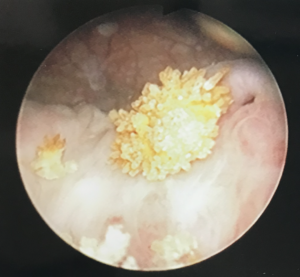Bladder Stones Have Been Found In Several IC Patients

Bladder stones are composed of crystals from minerals commonly found in urine (usually calcium and/or oxalates). They can occur if urine is extremely concentrated (i.e. dehydration) which allows the minerals to crystalize and form stones. They routinely grow on indwelling urinary catheters. They can also occur and emerge from the bladder wall after serious bladder wall injury. These crystals can be sharp and, as they float in urine, can irritate the bladder wall. New research has also revealed that stones are covered with pathogenic bacteria which can trigger infection.
The picture to the right was submitted by a patient who began passing what they thought were kidney stones. After passing dozens or late painful stones, cystoscopic examination revealed that he was actually struggling with stones emerging directly from his bladder wall, the result of severe surgical damage to the bladder. The stones were removed via an outpatient procedure but continued to develop requiring multiple procedures. Eventually, once healing occurred, the stones stopped growing.
Another IC patient who struggled with IC symptoms for several years finally agreed to have a cystoscopy to allow the doctor to examine her bladder wall. She was stunned when they discovered a large, rough bladder stone. Once removed, her symptoms resolved.
Bladder stones are remarkably common throughout the world. Up to 12% of men and 5% of women will develop a urinary stone by the age of 70. Patients who consume an excess of oxalates (greater than 40mg per day) or who struggle with bacterial overgrowth or pancreatic disease have a higher risk, as well as patients who take high doses of Vitamin C and/or have a family history of urinary stones. Because stones are composed of sharp crystals (mostly calcium oxalate), when they rub against the bladder wall they cause microscopic injuries and irritation. Large stones can also obstruct urine flow. Symptoms include blood in urine, symptoms of infection and renal colic. A variety of therapies are available depending upon the type and size of stones a patient may have.
Helpful Links
- Mayo Clinic Bladder Stones – https://www.mayoclinic.org/diseases-conditions/bladder-stones/symptoms-causes/syc-20354339
- Preminger G. Urinary Calculi. Merck Manual Professional Version. March 2018 – https://www.merckmanuals.com/professional/genitourinary-disorders/urinary-calculi/urinary-calculi
